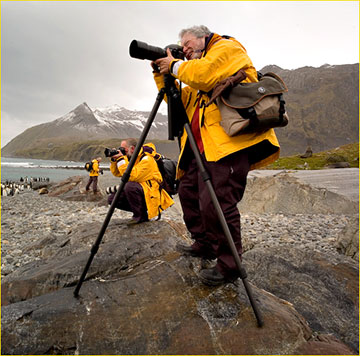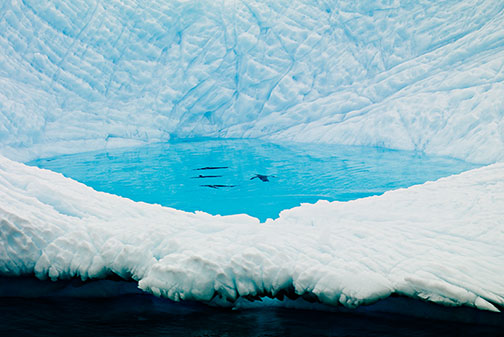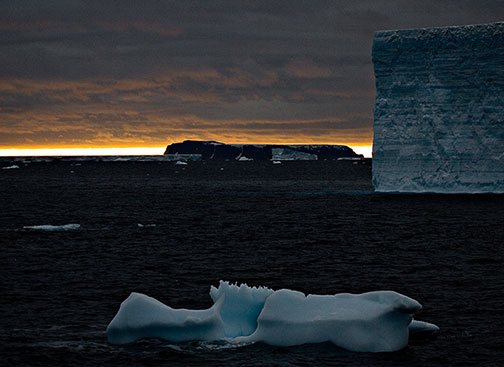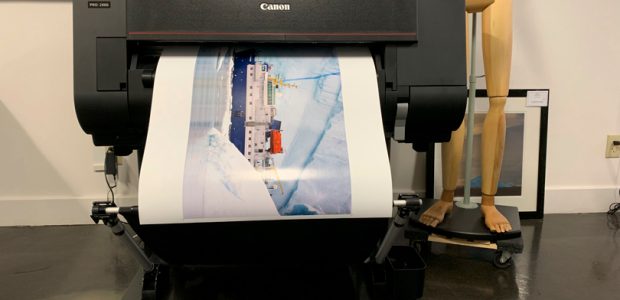I traveled onthis shootwith three camera systems – a Hasselblad H2 with a Phase One P45 back and three lenses (35mm, 50-110mm & 210mm); a Canon 1Ds MKII with three lenses, a 24-105mm IS, a 70-200mm f/2.8L IS and 100-400mm f/5.6 L IS; and a Leica M8 with a couple of lenses. In addition I had along a Macbook and four portable hard drives totaling 250 GB of storage. My software of choice for raw processing and editing was Adobe Lightroom. I traveled with two camera bags, the newThinktank International, and a Dryzone 200. My tripod was the newInduro C413with aRRS BH55ballhead.
Over a three week period in the Falklands, South Georgia and the Antarctic Peninsula I shot 7,024 frames totaling 182 Gigabytes. I shot roughly equally with the Canon and the Hasselblad. (More on this below). I ended up with some 92 frames which I consider worth printing, and a dozen which are portfolio / exhibition grade. Three of these are among the best work which I feel that I have ever done.
There were nearly 50 photographers on theexpedition, including the instructors and expedition staff. These ranged from our well known and highly regarded teachers, to several photographers with international reputations, as well as a variety of semi-pro and amateur photographers from around the world, including the USA, Canada, Finland, England, Australia, Ireland, Hungary, France and Peru.

Photo by Kevin Raber
__________________________________________________________
Bags – Roll One, Pack the Other
International air travel has become a huge hassle for photographers (and not just photographers). How do we get all our gear safely from one part of the world to another, when not getting ones luggage in time or having it lost or stolen can mean a complete disaster in terms of ones assignment or vacation.
Putting everything in Pelican cases and putting them through as checked luggage is one approach. Simply pay the overweight, and be done with it. But there are two risks here. One is that the bags will not arrive at the same time or day that you do, as is the case with checked luggage all too frequently, and the second is theft. A Pelican case says "I contain something fragile and expensive.", and although baggage theft isn’t that common, it does happen.
My approach is to travel with everything that I absolutely have to have for a shoot in my carry-on. This means a bag that is overhead compartment legal (if not weight legal). The newThinktank Internationalis one very good choice for this. I then also carry a shoulder bag which contains my laptop and hard drives, as well as other essentials such as wallet, passport, etc.
The Thinktank has wheels, which make makes schlepping in and out of airports that much easier. But on location this isn’t the most usable type of bag. A backpack is much more versatile. So what I do is pack all of my accessory gear, such as cables and chargers, along with an extra lens or two additionally protected with bubble wrap in a backpack camera bag (in this case a Dryzone 200), and then put that in my duffle bag, surrounded by clothes.
When I get to my destination I simply swap the contents of the two bags, putting my camera gear in the backpack for daily use, and the chargers and cables and such in the rolling hard bag.
My tripod is similarly packed in my duffle bag, and whatever space in that bag that’s left over gets filled with clothes, boots, toilet kit and the like.

Penguin Pool. Antarctica – February, 2007
Hasselblad H2 with 210mm lens and Phase One P45 back @ ISO 100
__________________________________________________________
Storage
It’s very hard to know how much file storage to bring on a trip like this. Three weeks of constant daily shooting is a long time. My 250 GB of storage was sufficient, since I ended up shooting just under 200 GB of files. But, this didn’t allow for a complete backup of everything in the field, which I regard as amust do. I consequently ended up borrowing space on one of my colleague Chris Sanderson’s hard drives so that I could have a full backup at all times.
My approach now that I use Lightroom both in the field and the office is to import from shot cards simultaneously to two drives. This way, even in the event of a head crash or other disaster with one of the drives, I know that I always have a backup.
When I travel I then put my primary set of drives in one bag, and the secondary set in the other. This is to protect against the loss or theft of a carryon bag. And then, to add a third level of protection, I took all of mySelectsas culled during the trip, and exported them from Lightroom to DNG files. These totaled just under 100 files, and 4GB. These I placed on a pocket sized 4GB flash card, which always remained in my breast pocket.
An overabundance of caution? I don’t think so. In my experience, the adage that "shit happens" is all too true, and whatever we can do to guard against Murphy’s worst predations is a worthwhile investment of time and money.
__________________________________________________________
Leica M8
There were four people aboard who carried Leica M8’s, myself among them. I primarily used mine in Buenos Aires for a bit of street shooting, and aboard ship for some snapshots of ship life. My only real problem was that the 67mm filter holder on the new 16-18-21mm Tri-Elmar jammed on, freezing the aperture ring. Some dissection followed and the eventual solution when I finally was able to remove it showed that there is a thick rubber O-ring used to seal both it and the lens shade, but that it is very easy for this to become cross-threaded when the filter and shade are being interchanged. Once this happens and the ring is dislodged, it appears impossible to get it to work properly again. I have found that I now have to use a bit of black plastic electrical tape to hold the lens shade in place. Not the usual quality of materials and construction that one expects from Leica.
Two of the other M8 users had more serious problems. One found that his two week old camera was dead on the first day of the trip at Buenos Aires airport. Just dead. No physical damage, just non-operational. We tried multiple batteries, incantation in medieval German, and a bit of whacking with the heal of the hand, but nothing worked. Needless to say, he was not amused, and had some choice things to say about Leica’s QC of their new cameras.
Another person had intermittent problems with their M8, with it ceasing to operate after just a small number of frames, even with a freshly charged battery. A new battery would bring it back to life, but again for only a short while. Either the camera’s battery regulation circuit was scrozzled, or the charger’s. The fourth M8 user had no problems with their camera even though it was used extensively under all sorts of conditions.
__________________________________________________________
Canon
About 85% of the trip’s members were shooting with Canon gear, mostly 1Ds MKII. There were a couple of 1D MKII and 5D’s, with several people having Rebel XT and XTi bodies as backups.
There were quite a few camera failures, most of them occasioned by our shooting in rain on the first day ashore in The Falklands. The rain was not heavy – more a persistent drizzle than a heavy rain, but it took its toll. In all, 90 minutes of wet shooting produced six 1Ds MKII cameras which stopped working for one reason or another. Three of them recovered after a night of drying out. Three remainedhors de combatfor the rest of the trip.
Three Canon 5D’s died that day, with one subsequent recovery. Two Rebel XTi’s lost their rear LCD’s, though otherwise continued to work (which is a real hassle, because though one can keep shooting, there’s no way to change any settings, or at least to know what the changes are).
We also lost two video cameras, one with a dead sound board and the other a total cardiac arrest. Several lenses bit the dust during the trip, including two Canon 70-210mm f/2.8L IS, and a Canon 28-135mm.

Sunset Icebergs. Antarctica, February, 2007
Canon 1Ds MKII with 100-400mm lens @ ISO 160
__________________________________________________________
Nikon
There were 5 Nikon users on the trip, with various bodies – mostly D200’s. There were no reports of any Nikon problems or failures.
__________________________________________________________
Medium Format
There were four H series Hasselblad users onboard, including me. Three of us used H1 and H2 bodies with Phase One P45 backs, while one person used an H3D with its included 39MP back. There were no camera failures or back problems, but one person’s 210mm Hasselblad lens bit the dust early in the trip, for no apparent reason.
This trip was a revelation for me with regard to shooting medium format hand-held on a moving platform. Over decades of shooting medium format I can recall only a handful of instances where I have worked hand-held. For me an MF camera belongs on a tripod, since my goal when shooting with anything other than 35mm is for the highest image quality possible (otherwise, why bother?). Hand holding and optimum image quality have always been antithetical in my mind. For me the hand grip on MF cameras is for picking up the camera when placing it on a tripod.
I had brought along the Hasselblad H2 and P45 back for use on land with a heavy duty tripod. But, with the instant feedback possible when working aboard ship in Antarctica (take a shot on deck, pop into the cabin and be able to review the results at 100% on-screen in just a couple of minutes), I did some early experiments and quickly came to the conclusion that working hand-held on a moving ship, even with a moderately long lens was indeed possible, just so long as the light levels weren’t too low. (Using a tripod aboard ship is pointless as it transmits vibration from the ship’s engine. The human body is a much better absorber of vibration).
My tests proved to me that I could shot hand-held and get excellent results as long as I shot at a shutter speed of at least 2X the reciprocal of the len’s focal length. In other words, I could hand hold my 210mm lens as long as the shutter speed was at least 1/500 sec.
I shared this discovery with Bill Atkinson, another unrepentant tripod user, and he found essentially the same thing to be true. So we both proceeded to shoot hand-held with our H1/H2 / P45 systems both from the deck of the ship as well as when shooting from Zodiacs. My technique was to set the camera in shutter priority mode with a shutter speed of 1/500 sec (when using the 210mm, which was the main lens used for icebergs, whales, and distant vistas), and then let the camera set the aperture as needed; dialing in anywhere from +1 to +1.5 exposure compensation, depending on the amount of sky, bergs or glaciers in the frame.

Blue Lace Iceberg. Antarctica – February, 2007
Hasselblad H2 with 210mm lens and P45 back @ ISO 100
__________________________________________________________
Other Cameras
Other than the cameras mentioned thus far, there was one photographer shooting with a Mamiya AFD system and a P45 back. Another was using the new Pentax 10D, and neither reported any problems.
One person was shooting film, with a Mamiya 7 II, but since his luggage was lost on the way to Argentina he only had 3 rolls of film for the entire trip.
__________________________________________________________
Bad Cards & Accidental Erasures
One of the worst things that can happen on a shoot is to find oneself with a corrupted or accidentally erased memory card. I’ll tell my own anecdote in a moment, but first I should mention that when you have 50 photographers working together for three weeks, and the giggage mounts up, accidents and misadventures are bound to happen.
We had at least a half dozen instances of people who had corrupted memory cards, or who needed to recover files from cards once they had been reformatted. Fortunately a couple of people had a program on their laptops calledPhotorescue, which in every instance was able to save the day.
Other data recovery programs, such as those now provided free by card makers such as Sandisk and Lexar just didn’t cut it. Sometimes a few files could be recovered, but not always, and not all files. WithPhotoRescuea complete recovery was possible almost every time. As soon as I got home I downloaded a copy – it’s available for both Windows and Mac OSX. Don’t leave home without it.A review on Imaging Resourcetells you all about this fine and inexpensive program.
My own near disaster occurred after the first day ashore shooting in South Georgia with the Hasselblad and P45 back. My usual routine is to copy cards to a hard drive and then once safely copied, to start reviewing them. But since I have now changed my workflow to Lightroom, and like its ability to import from a card reader to two drives simultaneously (thus making a backup in real time), this is what I did, along with shots made with my Canon 1Ds MKII.
That evening in my cabin after dinner, once the files were all copied over, I started reviewing the thumbnails on screen. Everything looked fine, and so pouring another glass of wine I popped the CF cards into the P45 and reformatted them for use the next day.
I then saw one particular thumbnail that looked interesting and clicked on it to view at full size.Oh oh!Nothing happened. What I quickly discovered was that Lightroom had only imported the P45’s built in thumbnails, not the entire file. (P45 files are not "officially" supported by Lightroom. Thomas Knoll had kindly put in preliminary support for P45 files for Bill Atkinson and me for our Lightroom shoot in Iceland in summer ’06). Please note that this bug doesnotexists with any other type of camera files.
I tried two file recovery programs that I had on my Macbook, but nothing would recover the files. I then went to the ship’s bar (our evening hang-out), and asked if anyone had any stronger medicine. A couple of people hadPhotorescue, and within the hour 97 of 102 files on the card had been rescued.
This story was to be repeated throughout the trip, with someone every day or two having either a corrupted or accidentally formatted card, and every time full or almost full recovery was possible. Forewarned is forearmed.
Ps:The P45 / Lightroom solution was to go back to what I had always been doing, which is to copy the files from the card to a hard drive, and then Import into Lightroom, rather than to use the program’s auto-import function. Of course Auto-import worked perfectly with all my other camera files.
__________________________________________________________
Closing Thoughts
Some months before the trip I wrote to all members and suggested that a backup camera was almost a must, and that traveling on such a long, remote and expensive expedition with just one camera body was just too risky. I suggested that if they had a low-to-mid range camera this was an excuse to get a better one, and if they were in search of a small and inexpensive backup, this was the excuse they needed to purchase one of those.
Apparently everyone took my advice, because though there were numerous camera failures no one found themselves cameraless.
As for why the majority of the camera failures seen on this trip were Canon, the answer is because 85% of the trip’s members were shooting Canon. Simple statistics.
Nevertheless the number of cameras that succumbed to rain damage was surprising, especially 1D MKII and 1Ds MKII bodies, which are typically very water resistant. I have no explanation for the high attrition rate, but i know that a new camera rain cover is now on my shopping list.
__________________________________________________________
Thanks
This trip had no corporate sponsors. But Epson did provide us with a Stylus Photo 2400 and a couple of Picturemate printers, along with paper and inks. After the trip these were subsequently donated to a school in Ushuia. Thanks Epson. We all appreciated it.
Thanks as well to Kevin Raber of Phase One who brought along extra medium format cameras and Phase One backs which were freely available to workshop members to borrow during the trip.
And a final word of thanks to our instructors – Steve Johnson, J.P. Caponigro, Jeff Schewe and Seth Resnick. Great traveling companions, and great teachers. Thanks need to be expressed as well to Bill Atkinson and Ian Lyons, who though not officially instructors on this expedition were very giving of their time and knowledge. And of course, a round of applause to a great group of participants. Your humour and patience and enthusiasm were much appreciated.
Thanks all!
The 2007 Luminous Landscape Antarctic Expedition
UPDATE
I looked at the site’s usage stats on the day after this article was first published and was astonished to see a huge spike in visitors. It quickly was evident that the reason was a large number of people on various forums discussing the equipment failures that we had in Antarctica, especially those caused by rain.
I won’t enter the debate, but the partisan bikkering online over this is quite astonishing. What I will add are two comments.
1: We were unprepared for rain that day in South Georgia. We found ourselves ashore, it started to rain, and we kept shooting. None of us had anything more than a hand towl or plastic bag for protection of our equipment. There was nowhere to go for shelter, and short of leaving our cameras in their bags nothing to do except keep shooting in an extraordinary environment.
2: If there had been 45 Nikon and 5 Canons in use, rather than the other way round, I think it likely that the shoe would have been on the other foot.
I have used my Canon 1Ds and 1Ds MKII in snow stroms, dust storms, heavy rain and worse. I’ve never had one die. Similarly in past years with Nikon gear. On my trip to Namibia last year the front element fell off a Hasselblad lens on its third day of use. The same thing happened to a new Canon 24-70mm f/2.8L on a shoot in Costa Rica a few years ago.
Pros and ardent amateurs use their equipment in all sorts of conditions, sometimes harshly, and sometimes not. But gear does fail. Sometimes its the elements, sometimes abuse, and yes, sometimes poor craftsmanship and materials. But no one should draw any unwarrented conclusions from this report. There just arent enough facts available, and the sample was highly scewed statistically.
You May Also Enjoy...
ImagePrint Does Canon
FacebookTweet Colorbyte Adds Canon Printers To Their Print Layout Program If you are a regular reader of Luminous-Landscape, you will know that I am a


